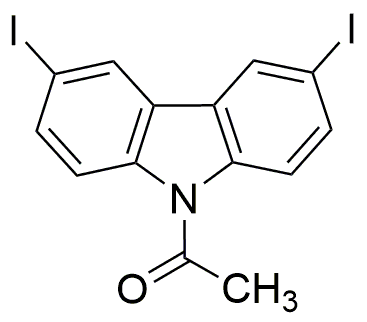9-Acetyl-3,6-diiodocarbazole is widely utilized in research focused on:
- Organic Electronics: This compound is used in the development of organic light-emitting diodes (OLEDs), enhancing the efficiency and color range of displays in devices like smartphones and televisions.
- Photovoltaic Cells: It serves as a key material in organic solar cells, contributing to improved energy conversion efficiency, making solar technology more accessible and sustainable.
- Fluorescent Probes: The compound is employed in biological research as a fluorescent probe, allowing scientists to visualize cellular processes with high specificity and sensitivity.
- Medicinal Chemistry: Its unique structure makes it a candidate for drug development, particularly in targeting specific cancer cells, potentially leading to more effective treatments with fewer side effects.
- Material Science: Used in the synthesis of advanced materials, it aids in creating polymers with enhanced thermal and mechanical properties, beneficial for various industrial applications.
Información general
Propiedades
Seguridad y normativas
Aplicaciones
9-Acetyl-3,6-diiodocarbazole is widely utilized in research focused on:
- Organic Electronics: This compound is used in the development of organic light-emitting diodes (OLEDs), enhancing the efficiency and color range of displays in devices like smartphones and televisions.
- Photovoltaic Cells: It serves as a key material in organic solar cells, contributing to improved energy conversion efficiency, making solar technology more accessible and sustainable.
- Fluorescent Probes: The compound is employed in biological research as a fluorescent probe, allowing scientists to visualize cellular processes with high specificity and sensitivity.
- Medicinal Chemistry: Its unique structure makes it a candidate for drug development, particularly in targeting specific cancer cells, potentially leading to more effective treatments with fewer side effects.
- Material Science: Used in the synthesis of advanced materials, it aids in creating polymers with enhanced thermal and mechanical properties, beneficial for various industrial applications.
Documentos
Hojas de datos de seguridad (HDS)
La SDS proporciona información de seguridad completa sobre la manipulación, el almacenamiento y la eliminación del producto.
Especificación del producto (PS)
La PS proporciona un desglose completo de las propiedades del producto, incluida la composición química, el estado físico, la pureza y los requisitos de almacenamiento. También detalla los rangos de calidad aceptables y las aplicaciones previstas del producto.
Certificados de análisis (COA)
Busque certificados de análisis (COA) ingresando el número de lote del producto. Los números de lote y de partida se pueden encontrar en la etiqueta de un producto después de las palabras "Lote" o "Lote".
Número de catálogo
Número de lote/lote
Certificados de origen (COO)
Este certificado de origen confirma el país en el que se fabricó el producto y también detalla los materiales y componentes utilizados en él y si se deriva de fuentes naturales, sintéticas u otras fuentes específicas. Este certificado puede ser necesario para cumplir con las normativas aduaneras, comerciales y regulatorias.
Número de catálogo
Número de lote/lote
Hojas de datos de seguridad (HDS)
La SDS proporciona información de seguridad completa sobre la manipulación, el almacenamiento y la eliminación del producto.
DownloadEspecificación del producto (PS)
La PS proporciona un desglose completo de las propiedades del producto, incluida la composición química, el estado físico, la pureza y los requisitos de almacenamiento. También detalla los rangos de calidad aceptables y las aplicaciones previstas del producto.
DownloadCertificados de análisis (COA)
Busque certificados de análisis (COA) ingresando el número de lote del producto. Los números de lote y de partida se pueden encontrar en la etiqueta de un producto después de las palabras "Lote" o "Lote".
Número de catálogo
Número de lote/lote
Certificados de origen (COO)
Este certificado de origen confirma el país en el que se fabricó el producto y también detalla los materiales y componentes utilizados en él y si se deriva de fuentes naturales, sintéticas u otras fuentes específicas. Este certificado puede ser necesario para cumplir con las normativas aduaneras, comerciales y regulatorias.


